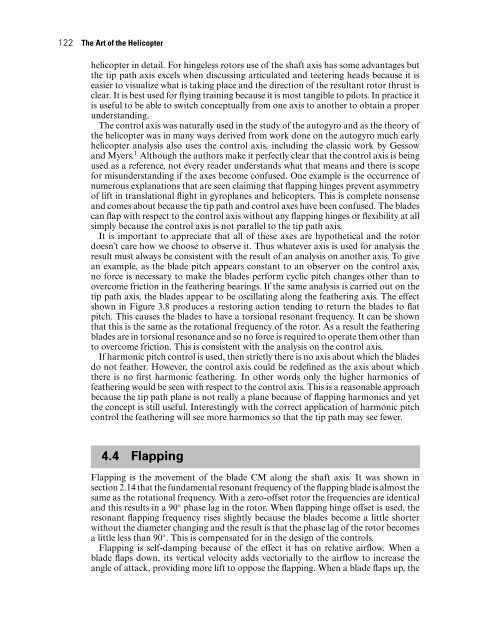The Art of the Helicopter John Watkinson - Karatunov.net
The Art of the Helicopter John Watkinson - Karatunov.net
The Art of the Helicopter John Watkinson - Karatunov.net
You also want an ePaper? Increase the reach of your titles
YUMPU automatically turns print PDFs into web optimized ePapers that Google loves.
122 <strong>The</strong> <strong>Art</strong> <strong>of</strong> <strong>the</strong> <strong>Helicopter</strong><br />
helicopter in detail. For hingeless rotors use <strong>of</strong> <strong>the</strong> shaft axis has some advantages but<br />
<strong>the</strong> tip path axis excels when discussing articulated and teetering heads because it is<br />
easier to visualize what is taking place and <strong>the</strong> direction <strong>of</strong> <strong>the</strong> resultant rotor thrust is<br />
clear. It is best used for flying training because it is most tangible to pilots. In practice it<br />
is useful to be able to switch conceptually from one axis to ano<strong>the</strong>r to obtain a proper<br />
understanding.<br />
<strong>The</strong> control axis was naturally used in <strong>the</strong> study <strong>of</strong> <strong>the</strong> autogyro and as <strong>the</strong> <strong>the</strong>ory <strong>of</strong><br />
<strong>the</strong> helicopter was in many ways derived from work done on <strong>the</strong> autogyro much early<br />
helicopter analysis also uses <strong>the</strong> control axis, including <strong>the</strong> classic work by Gessow<br />
and Myers. 1 Although <strong>the</strong> authors make it perfectly clear that <strong>the</strong> control axis is being<br />
used as a reference, not every reader understands what that means and <strong>the</strong>re is scope<br />
for misunderstanding if <strong>the</strong> axes become confused. One example is <strong>the</strong> occurrence <strong>of</strong><br />
numerous explanations that are seen claiming that flapping hinges prevent asymmetry<br />
<strong>of</strong> lift in translational flight in gyroplanes and helicopters. This is complete nonsense<br />
and comes about because <strong>the</strong> tip path and control axes have been confused. <strong>The</strong> blades<br />
can flap with respect to <strong>the</strong> control axis without any flapping hinges or flexibility at all<br />
simply because <strong>the</strong> control axis is not parallel to <strong>the</strong> tip path axis.<br />
It is important to appreciate that all <strong>of</strong> <strong>the</strong>se axes are hypo<strong>the</strong>tical and <strong>the</strong> rotor<br />
doesn’t care how we choose to observe it. Thus whatever axis is used for analysis <strong>the</strong><br />
result must always be consistent with <strong>the</strong> result <strong>of</strong> an analysis on ano<strong>the</strong>r axis. To give<br />
an example, as <strong>the</strong> blade pitch appears constant to an observer on <strong>the</strong> control axis,<br />
no force is necessary to make <strong>the</strong> blades perform cyclic pitch changes o<strong>the</strong>r than to<br />
overcome friction in <strong>the</strong> fea<strong>the</strong>ring bearings. If <strong>the</strong> same analysis is carried out on <strong>the</strong><br />
tip path axis, <strong>the</strong> blades appear to be oscillating along <strong>the</strong> fea<strong>the</strong>ring axis. <strong>The</strong> effect<br />
shown in Figure 3.8 produces a restoring action tending to return <strong>the</strong> blades to flat<br />
pitch. This causes <strong>the</strong> blades to have a torsional resonant frequency. It can be shown<br />
that this is <strong>the</strong> same as <strong>the</strong> rotational frequency <strong>of</strong> <strong>the</strong> rotor. As a result <strong>the</strong> fea<strong>the</strong>ring<br />
blades are in torsional resonance and so no force is required to operate <strong>the</strong>m o<strong>the</strong>r than<br />
to overcome friction. This is consistent with <strong>the</strong> analysis on <strong>the</strong> control axis.<br />
If harmonic pitch control is used, <strong>the</strong>n strictly <strong>the</strong>re is no axis about which <strong>the</strong> blades<br />
do not fea<strong>the</strong>r. However, <strong>the</strong> control axis could be redefined as <strong>the</strong> axis about which<br />
<strong>the</strong>re is no first harmonic fea<strong>the</strong>ring. In o<strong>the</strong>r words only <strong>the</strong> higher harmonics <strong>of</strong><br />
fea<strong>the</strong>ring would be seen with respect to <strong>the</strong> control axis. This is a reasonable approach<br />
because <strong>the</strong> tip path plane is not really a plane because <strong>of</strong> flapping harmonics and yet<br />
<strong>the</strong> concept is still useful. Interestingly with <strong>the</strong> correct application <strong>of</strong> harmonic pitch<br />
control <strong>the</strong> fea<strong>the</strong>ring will see more harmonics so that <strong>the</strong> tip path may see fewer.<br />
4.4 Flapping<br />
Flapping is <strong>the</strong> movement <strong>of</strong> <strong>the</strong> blade CM along <strong>the</strong> shaft axis. It was shown in<br />
section 2.14 that <strong>the</strong> fundamental resonant frequency <strong>of</strong> <strong>the</strong> flapping blade is almost <strong>the</strong><br />
same as <strong>the</strong> rotational frequency. With a zero-<strong>of</strong>fset rotor <strong>the</strong> frequencies are identical<br />
and this results in a 90 ◦ phase lag in <strong>the</strong> rotor. When flapping hinge <strong>of</strong>fset is used, <strong>the</strong><br />
resonant flapping frequency rises slightly because <strong>the</strong> blades become a little shorter<br />
without <strong>the</strong> diameter changing and <strong>the</strong> result is that <strong>the</strong> phase lag <strong>of</strong> <strong>the</strong> rotor becomes<br />
a little less than 90 ◦ . This is compensated for in <strong>the</strong> design <strong>of</strong> <strong>the</strong> controls.<br />
Flapping is self-damping because <strong>of</strong> <strong>the</strong> effect it has on relative airflow. When a<br />
blade flaps down, its vertical velocity adds vectorially to <strong>the</strong> airflow to increase <strong>the</strong><br />
angle <strong>of</strong> attack, providing more lift to oppose <strong>the</strong> flapping. When a blade flaps up, <strong>the</strong>










